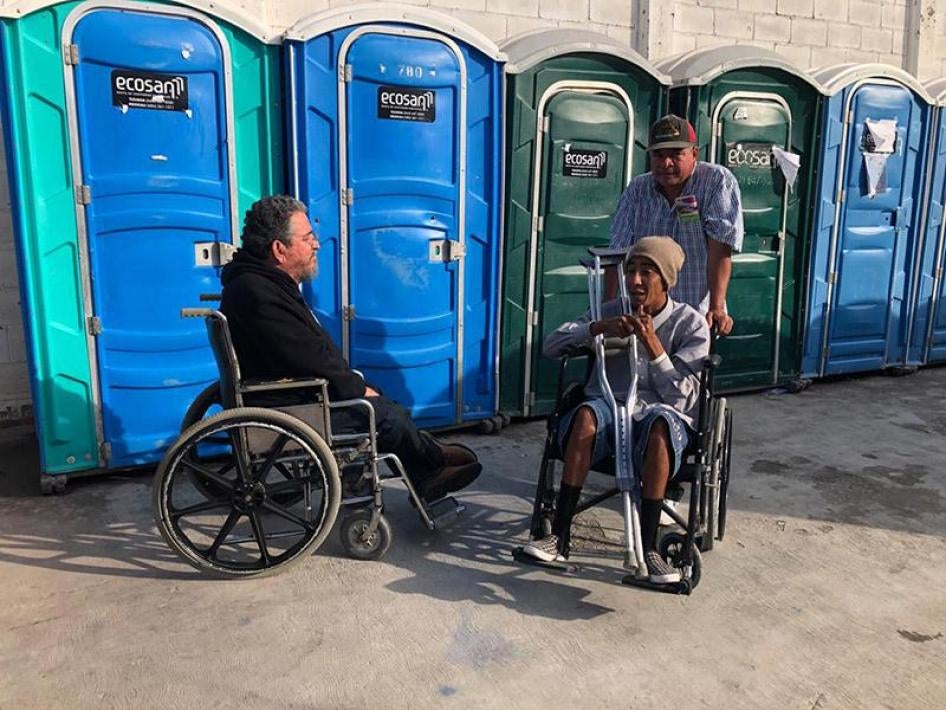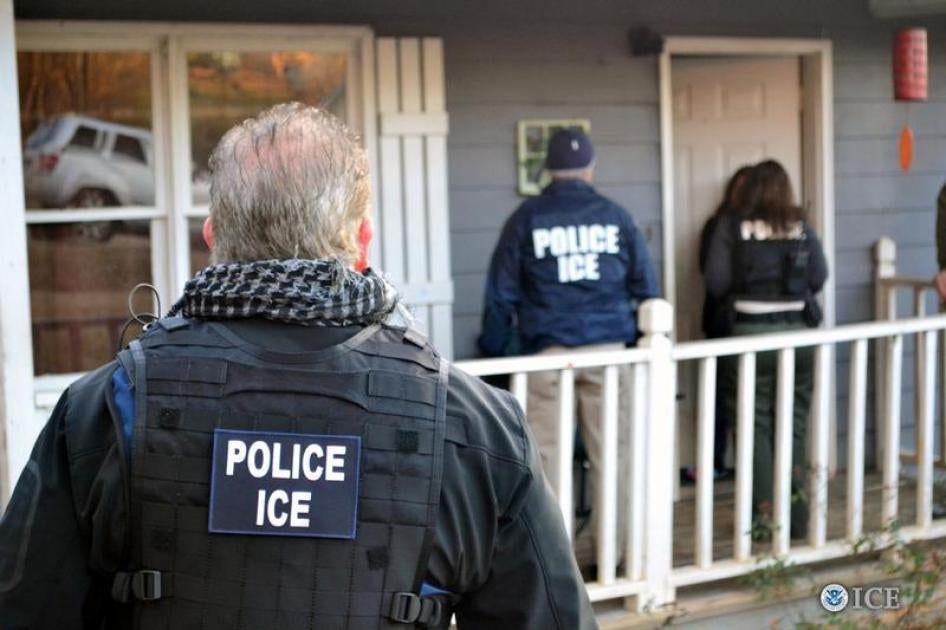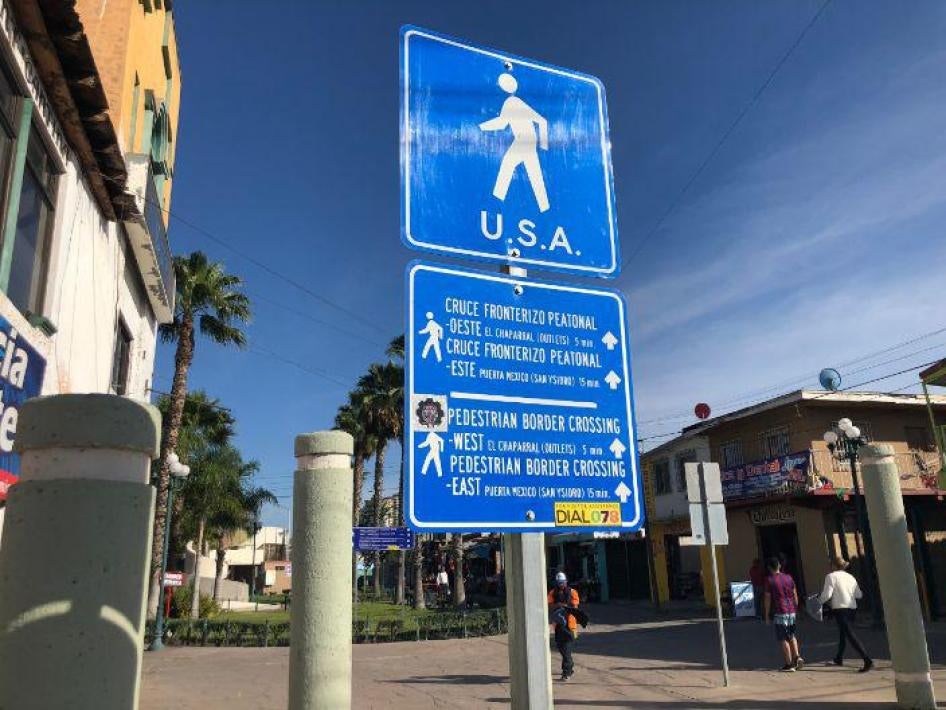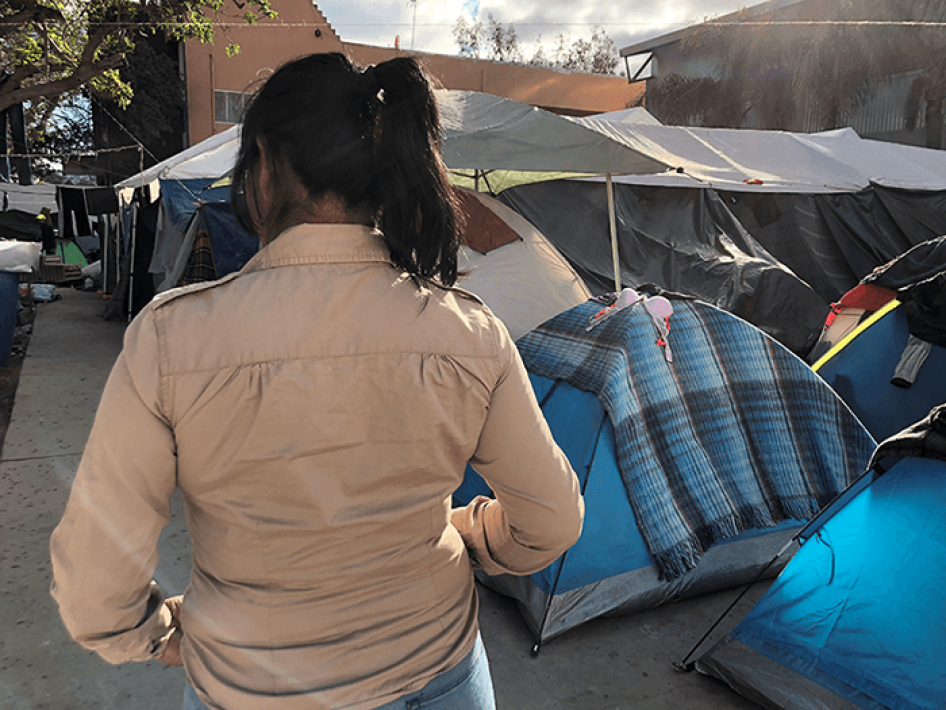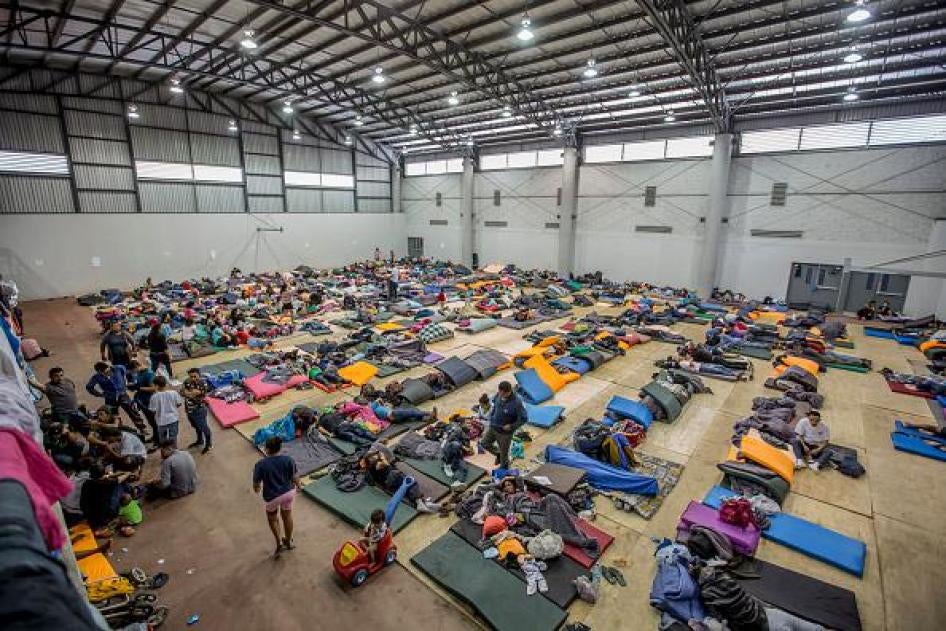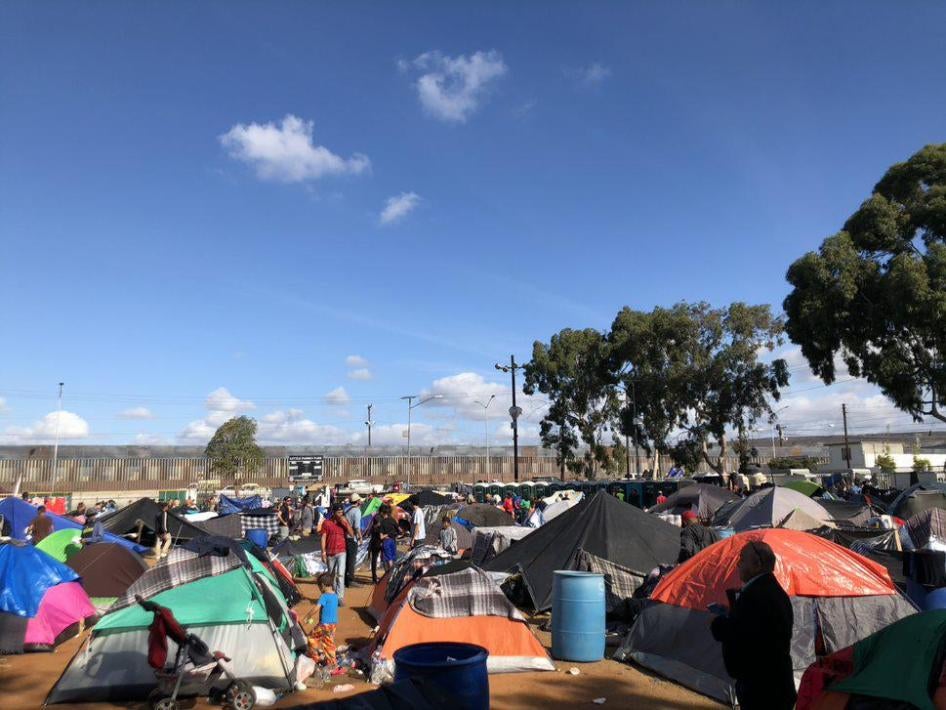At the Border

Hunger, trafficking, exhaustion, death; those are some the risks faced by Central American migrants during their journey. Whether they joined caravans or trekked alone, why would mothers, children, fathers and brothers risk so much to leave their homeland? Over the next few weeks, we’ll be sharing some of their stories and examine how recent US rule changes may impact how they are being treated at the border.
Life With a Disability in the Migrant Caravan
In order to use the bathroom in the Tijuana migrant shelter, I had to be carried up a flight of stairs. Living in Latin America with a disability has never been a simple task; daily activities can be extremely difficult due to the lack of accessibility and specific supports for living independently. As a wheelchair user living in Mexico City, I had to be carried down two big stairs to be able to board my plane to get from the capital to Tijuana.
But things are much worse for the nine people with disabilities I met who traveled from different parts of Central American and Mexico to the US border as part of the migrant caravans. In November, their journey north in search of a life without violence and discrimination had stopped at El Barretal shelter in Tijuana, a town by the US border. Those who spoke with me were among the 12 migrants with disabilities registered by the Baja California state Human Rights Commission and other agencies. But the number is surely an understatement; people who may have less visible disabilities, such as developmental disabilities like autism or psychosocial disabilities (mental health conditions), were not identified.
María and Ximena (not their real names) are two deaf women who arrived in Tijuana from Honduras. Like many other members of the caravans, they came to Tijuana by asking for bus rides and sometimes walking part of the way.
Life With a Disability in the Migrant Caravan
In order to use the bathroom in the Tijuana migrant shelter, I had to be carried up a flight of stairs. Living in Latin America with a disability has never been a simple task; daily activities can be extremely difficult due to the lack of accessibility and specific supports for living independently. As a wheelchair user living in Mexico City, I had to be carried down two big stairs to be able to board my plane to get from the capital to Tijuana.
But things are much worse for the nine people with disabilities I met who traveled from different parts of Central American and Mexico to the US border as part of the migrant caravans. In November, their journey north in search of a life without violence and discrimination had stopped at El Barretal shelter in Tijuana, a town by the US border. Those who spoke with me were among the 12 migrants with disabilities registered by the Baja California state Human Rights Commission and other agencies. But the number is surely an understatement; people who may have less visible disabilities, such as developmental disabilities like autism or psychosocial disabilities (mental health conditions), were not identified.
María and Ximena (not their real names) are two deaf women who arrived in Tijuana from Honduras. Like many other members of the caravans, they came to Tijuana by asking for bus rides and sometimes walking part of the way.
The “Criminal”
When asked about the migrant caravan recently, US Homeland Secretary Kirstjen Nielsen claimed that 600 “convicted criminals” are part of it. It’s unclear where the number comes from or if it is at all true – the Trump administration has lied before – but the implication is clear: These “aliens” are dangerous and shouldn’t be allowed to enter the United States.
The “criminal” narrative fancied by the president of the United States, who once broadly painted undocumented immigrants from Mexico as “rapists”, served as justification for the costly and unnecessary deployment of thousands of US servicemen and women to an already heavily fortified border, one patrolled by tens of thousands of heavily armed Customs and Border Protection (CBP) officers.
Given the “criminal” narrative’s traction in the US, I set out to try and find one of those so-called criminals at El Barretal, the new migrant shelter in Tijuana, amidst the groups of children playing, women chatting, and men queuing for food. As I finished an interview, a young man smiled at me, eager to talk. Little did I know I had finally found my “criminal”.
For his protection, we’ll call him Jose. He is 19-year-old, wears a fake-leather jacket, a baseball cap and worn-out sneakers. He is from a rural area of Honduras. Like so many others in the caravan, he had a tough childhood. “My father went to jail when my mother was pregnant with me. The gang killed him when he got out of jail,” he explained matter-of-factly. When Jose was 9, his mother left his stepfather, who was violent and abusive, he told me.
So Jose had to come up with a way to help financially support his mother and himself. “At age 10, I went to milk the cows,” he said. But that wasn’t enough. Soon, he migrated to Guatemala – on his own. He was 11 and found work in a small hotel-restaurant where he took orders from the patrons and helped in the kitchen. “The owner treated me well, as though he had adopted me, but eventually I returned to Honduras for Christmas and decided to stay at home,” Jose tells me.
That’s when the dream’s seed was planted. An uncle had come for an extended visit, straight from a large town in Texas, where he lived illegally. The uncle told him about the joys of life in the US: work, safety, the big life. Jose decided he wanted a part of it, too. So he left home again, at age 13, to try and find his way to the land of milk and honey, a distorted image of US life his uncle had imprinted in the young boy’s mind.
Along with a friend, Jose made it to Palenque, Mexico, from where they clandestinely boarded “La Bestia”, a northbound freight train. Just like them, many other migrants hid in the wagons, hoping to make it safely to their destination. They didn’t. “Around Chontalpa, the train stopped and around 15 members of the MS-13 came onboard with machetes and two guns,” Jose told me. “They wanted us to pay $100 each to pass, but I didn’t have that kind of money.”
Migrants were beaten and extorted – Jose managed to avoid paying, but he received no “password” from the notorious gang to prove to others further down the route that he had paid. At another stop, several hours later, other gang members came on board, asking for money, threatening those who didn’t have it. Jose and his friend jumped off the wagon, running for their lives.
After spending seven months working in Veracruz, Mexico, Jose continued his journey towards the US. His uncle helped him find a coyote – or human trafficker – who helped him cross into Texas alongside a few others. Once in the US, Jose said Border Patrol quickly found and arrested them. “I was detained for two months and they treated me well. An investigator asked if I had tattoos and if I had seen people killed by the gangs. I told her about my cousin and father who were killed,” Jose told me.
At the end of the two months, Jose said he was released to his uncle while his asylum claim was processed. For the first time since he was 9, he was enrolled in high school, he told me. For a while, things went well for Jose. He studied and lived with his uncle, presenting himself to the immigration court once every 3 or 4 months.
But in 2015, the dream went awry when Jose missed an appointment with the immigration court. It was scheduled for 11am, he said, but his uncle couldn’t take him and he struggled to get there by public transportation. He arrived 3 hours late. The court was closed. “I went back a few days later and they told me that I had to find myself a lawyer,” Jose said. When he called a few lawyers, he explained they all told him the process would cost him around US$10,000.
All this, and Jose was only 16.
So Jose decided to go underground. “I was afraid that ICE would show up at my school, so I abandoned my classes, found a job in construction, and rented a room elsewhere,” he told me. Around that time, Jose had his first encounter with those policing the American dream.
“I was coming back from work with friends and we wanted to buy food but we were short a dollar. So I went to ask a Mexican who sat at a terrace nearby if he could lend me one,” Jose told me. The man refused and insulted Jose and his friends for being Honduran. The discussion got heated and the man pulled out a handgun, Jose said. A passerby called the police. By the time the officer showed up, Jose said he and his friends were walking away.
“When we saw the police car, we stopped. They arrested us, and I was accused of threatening the Mexican man,” he said. A judge sentenced him to 3 months in detention, but Jose got out after a month since he worked in the detention center’s kitchen and showed good behavior. By then, Jose had lost his spot in the apartment he and others rented as well as his job.
Jose being Jose, he quickly figured out a solution and found a new place to live, not too far from a gated community. But his trouble didn’t end there. “One night, a friend invited me to play PlayStation at his house. He was drunk, but I decided to go with him nonetheless. As we walked towards his place, a white security guard called out to us and said only those living in the area were allowed,” Jose said. When the security guard noticed Jose’s friend was drunk, he called the police. Both were arrested for trespassing. Jose was released after a month, without charges he said.
Jose said his third and final encounter with US law enforcement took place a few months later. Like many young people, Jose fell in love. And his girlfriend lived in the same gated community where he had been arrested for trespassing. But Jose being a young man in love, that didn’t stop him from entering it. The same guard however did. He had warned Jose not to come back to the area. Upon seeing him walking in the street, he followed him all the way up to Jose’s girlfriend home. And once more, he called the police, despite the young woman’s pleas to let him alone.
That was the final straw – Jose said he spent a month in county detention and was then transferred to immigration. “Two weeks after I got there, they had me sign a paper. I didn’t know what it was,” Jose explained. It turned out to be his deportation order. “One day, they came to my cell and said: ‘pick up your things, you’re going back to Honduras.’ I didn’t know what they were talking about…” Jose recalled.
US immigration officials cuffed Jose’s wrists and ankles and brought him aboard a plane. “I felt like an animal,” he told me. And a few hours later, he landed in the gang-ridden town of San Pedro Sula, Honduras. “I went to my grandparents, out in the mountain. They didn’t recognize me at first,” he says laughing. There, Jose worked in the coffee fields with his grandfather, “a hard-working man.”
Two years ago, Jose posted a photo of himself on Facebook, with the following text: “From the past, I don’t own anything, so I can move forward without looking back. Best to try and ignore the bad memories and continue living the present as I want it to be.” So when he heard of the Caravan leaving for the US, Jose didn’t think about it twice. He missed his friends and life there.
And so off he was again, hoping to make it back to the dream land.
But his chances are dim. If you listen to Secretary Nielsen, he is just a dangerous “convicted criminal,” anyway.
From Hell Through Hell
They fled the conflict-torn northwest region of Cameroon in July. They trekked through Nigeria, Benin, and Togo to make it to Ghana, some 1,500 kilometers west, from where they felt they could safely fly out. And fly out, they did – to Ecuador. They then trekked some more – roughly 8000 kilometers north – through Colombia, Panama, Central America, and Mexico, to finally make it to the El Chaparral border crossing, in Tijuana, right across from San Diego, California.
They were six women and four men, and they wouldn’t tell me their names. Their fear was something I’d seen in Cameroon, just a few months ago, when I travelled to their home region to investigate an emerging human rights crisis. There, a colleague and I found that government security forces were conducting a brutal campaign to combat a pro-independence insurgency and repress political protest across the country’s anglophone regions. More than 180,000 were displaced by the violence between December 2017 and July 2018.
The Cameroonian asylum seekers in Tijuana told me they fled because of arrests, torture, and violence. That wasn’t surprising. In April, I had documented how Cameroonian security forces arrested a 22-year-old student on suspicion of his involvement with the armed secessionists in the northwest region and tortured him to death. Men in uniform dropped his body a few days later at a local morgue and a medical professional confirmed he had died as a result of the beating: “The body had broken ribs – when you touch it you can hear it – and blood had come out of the anus,” he told me.
Like many others from Haiti and Southeast Asia, the Cameroonians I met flew to South America, because some countries in the region have welcoming visa-free policies for citizens of several nations, including Cameroon. From there, they crossed the notoriously dangerous Darien Gap, on the Colombia-Panama border, to move north to the US border. The gap is a 100 kilometers wide swathe of swampland, impenetrable forests, and wild animals: “It was hell,” a woman told me.
Thanks to Panamanian hunters they met in the jungle, the group managed to find its way and eventually make it back to civilization. From there, they continued their journey north, only to hit a wall in Tijuana – the waiting list.
The list is an unusual process, administered by migrants themselves but supervised by Mexican immigration officials. It emerged under the Obama administration, when US immigration officials began to “meter” the flow of asylum seekers – that is, to impose quotas on the number of asylum claims processed at the official ports of entry every day. And it is at the very root of the humanitarian crisis in Tijuana. As a result of the “metering,” a backlog of asylum seekers emerged on the Mexican side of the border, trapped in limbo as they waited to legally cross to claim asylum.
When I met the Cameroonians, their turn had finally come to claim asylum – after a month and one week of wait.
There’s no way of knowing whether their asylum claims will be accepted.
A New Shelter
The stadium Benito Juarez in #Tijuana will be emptied now, migrants to be brought in separate buses to the new, covered shelter in eastern Tijuana, much farther from the US border. Police, immigration and national human rights commission accompanying migrants. pic.twitter.com/KB5r41dnQG
— Jonathan Pedneault (@j_pedneault) November 30, 2018
Much better installations at the new shelter in #Tijuana. Migrants will have a roof and a dry floor to sleep tonight. But 45 minutes away by car from the border. pic.twitter.com/aXjGsm2QLx
— Jonathan Pedneault (@j_pedneault) November 30, 2018
Rain Soaks the Camp in Tijuana
Ten years visiting camps in Chad, Uganda, South Sudan, etc. Conditions today in #Tijuana’s migrant camp amongst the worst I’ve seen in my career: pic.twitter.com/vLRMCL5p9x
— Jonathan Pedneault (@j_pedneault) November 30, 2018
Thread: the rain at the migrant shelter in #Tijuana. Once again: #AvoidableCrisis pic.twitter.com/IQFXogcLYi
— Jonathan Pedneault (@j_pedneault) November 29, 2018
— Jonathan Pedneault (@j_pedneault) November 29, 2018
It’s raining in #Tijuana. The baseball field is turning into a maze of mud and garbage. But the migrants aren’t complaining - they’ve all seen worse. pic.twitter.com/9sl9lzvQmL
— Jonathan Pedneault (@j_pedneault) November 29, 2018
Four Women
Roselia, Ligia, Dilma, and Yoani are strangers, but they have much in common. They are all women from Honduras. They have all been forced to flee the epidemic of lawless violence that has gripped their country. And, they have all ended up here, camped out in the Benito Juarez Stadium of Tijuana, with thousands of other asylum seekers, hoping to start a new life in the United States.
Here are their stories (names have been changed).
Roselia is a 37-year-old single mother of four kids from the north of Honduras. Single, she told me, because the gangs murdered her partner twelve years ago – less than five months after they had killed her father.
“I was pregnant with the last one at the time. He brought me to the medical center to do an ultrasound and left. I never saw him again,” she told me near one of the water points where migrants wash their clothes at the Benito Juarez stadium. “Six days later, they found his body in a neighboring area, without teeth or documents. We recognized him thanks to his boxers.”
Despite the obvious trauma, Roselia remained in Honduras, working in a clothing shop for roughly $4 a day, trying to feed her kids. But five months ago, the gangs came back to meddle in Roselia’s life: “They came home and briefly kidnapped my 35-year-old brother because he didn’t want to join them. My mother intervened and prayed and thank God, they released him.”
Two months later, the gangs returned to the home, at night. “They searched me but thank god nothing else happened. I couldn’t sleep since. I came here because I couldn’t sleep there,” she said.
Ligia is 39-year-old single mother of four kids from the north of Honduras. Single, she told me, because she separated from her partner seven years ago. A seamstress, she made decent money, but when a new government came to power, electricity prices rose, eating away the little profits she made to sustain her family.
Five years ago, her 23-year-old brother, who was a Mara Salvatrucha (MS) gang member, was killed after visiting her while she lived in an area controlled by a rival gang, the 18. Her family put the blame on her. But that’s not why she joined the caravan, she said.
“Last year, I bought a phone from my son, who is 19. Recently, he got into an altercation with six men who stole the phone away from him. Since then, they keep calling and texting me, saying that if I don’t pay $400, they would kidnap my youngest son,” she told me. So Ligia fled her town and her shop, leaving behind her sustenance, to find refuge in another part of the country. Unable to start again from scratch, she decided to join the caravan.
Dilma is a 31-year-old single mother of five kids from the north of Honduras. She told me that the father of her first two children was killed by gangs 13 years ago and her husband committed suicide last year. That was just a few months before the municipal government came to dislodge the family from their home, along with ten other families, because a company was setting up shop and needed the land.
“We had lived there for 10 years, but the mayor said they couldn’t lose such a company just for a few families,” she told me. While the authorities promised them a new home, they never delivered.” Dilma was left to start again in an entirely new neighbourhood – one where the gang saw the newcomers as a threat, especially when they came from an area controlled by an enemy gang, like Dilma.
“After we moved to the new place, my 15-year-old brother came to visit. After a month and half, the mareros (gang) surrounded them and threatened him and he had to flee to a neighbouring department. Shortly after, he was killed,” she told me. But the gangs didn’t leave Dilma alone. Earlier this fall, three gang members came into her house as she stepped out of the shower. “They told me to come out into the street. I asked why. They said, ‘Why do you go around, talking about us?’ They wanted to kill me outside and not in front of my children,” she recalled.
Dilma refused to step out and they finally left, but not without telling her crying children that if she ever spoke of them again, they’d be back to kill her. As soon as they left, Dilma told me, she packed bags, took the little money she had, and ran to her mother in another town. She then left and joined the caravan, who was already in Mexico by then. She plans to ask for asylum. When I explained the process to her, and how difficult it would be, her eyes filled with water. “Life is really difficult,” she said.
Yoani is a 34-year-old single mother of five kids from the Atlantic coast of Honduras. She is single, she told me, because she divorced two years ago from her husband who abused her psychologically and sexually. “I did everything I could to try and protect our marriage, I went to church, I tried to fix things. But I suffered 20 years with him, and my daughters suffered too,” she said.
Three years ago, Yoani’s two elder daughters, then under 16-year-old, were raped by narcotraffickers. When the first was raped, Yoani’s husband blamed it on her. “Instead of supporting her, he diminished her. But no one goes out looking to be raped. And when they needed support, he didn’t give it to them,” she told me.
So Yoani sought a court order to make the end of her relationship official. It was a difficult step. “I had to stand up for myself and rebuild my self-esteem. But I had to fight for my children. I had to do this for them,” she explained.
Yet, even once the court ordered her husband to pay support, he refused and continued to harass her. So she joined the caravan: “I had to leave. I took that decision to ensure that what happened to me and my two elder daughters doesn’t happen to my other children. I wouldn’t have married if I had received support from my parts. And I would die if they had to live submitted to someone that abused them.”
What's Next for Asylum Seekers at the Border?
Grace Meng, senior researcher with HRW's US program, appears on Al Jazeera's The Stream to discuss US asylum policy. Watch the interview here.
El Salvador’s Ciudad Delgado, Where You Get Beaten for Sport
It was around 9pm when Rafael (not his real name) walked back home from the gym, late last year, in Ciudad Delgado, a suburb of El Salvador’s capital. The young industrial painter, 24 at the time, liked to read and exercise. The maras, or gangs that controlled his neighborhood liked to drink and drug themselves. As Rafael walked, exhausted and not paying attention, he collided with one such intoxicated gang members. One of four.
“The guy got really mad. There was a lot of people in the street, but as soon as this happened everyone just retreated in their houses and locked their doors,” Rafael told me while sitting in his small tent at the Benito Juarez stadium in Tijuana, Mexico, where he had traveled with the “Caravan” of migrants.
All alone, facing the four angry mareros, Rafael fought for his life and managed to run home to grab a baseball bat to defend himself.
I asked whether he couldn’t simply call the police. “The police is part of them… what good would that do, if I called the police?” he responded with a smile, probably thinking my question was naive.
As Rafael came out of his house, baseball bat in hand, the gang members were waiting for him at the corner. They quickly seized him and shot him in the leg. “They said that if I was disrespectful to them one more time, they would kill me.”
That was one of the gravest incidents Rafael faced, but hardly the only one: “The guys from the ’18’ were the ones to shoot me. But those from the MS [Mara Salvatrucha, a competing gang), they beat me at least seven or eight times. With their fists, once with a baseball bat.”
In Ciudad Delgado, you don’t live freely, Rafael said. So Rafael decided to leave. In 2013, he made it illegally to the US where he worked installing roofs for a little under two years. He decided to return to El Salvador when his mother got sick. “I don’t think the gringos ever knew I was in their country,” he said. Now he’s trying to cross once again and plans to ask for asylum, because the gangs have become too much of a problem.
“I have 12 years of study and I like to work,” Rafael told me. “I think I am a good person. I don’t want El Salvador to turn me into a bad person.”
From Picking Coffee to Navigating Asylum at the US Border
Sebastian (not his real name) is a soft-spoken 28-year-old father of one. He is from the mountainous southern region of Honduras, bordering Nicaragua. It’s a rural area, where his parents own four hectares of coffee plantations.
Ever since he can remember, Sebastian has worked in his family’s coffee fields. But a few years ago, his family was forced to take out a large loan to stay in business. When they could not pay it back because of decreasing coffee prices and coffee-plant illnesses, they lost five of their original nine hectares of land to the lender. But that’s not why Sebastian left Honduras.
He left because of the gangs.
“In our area, the ‘Maras’ are the ones in control. They raise taxes for themselves,” he explained. “The police are five kilometers away. They’re not present.”
Without police presence and with gangs rampant, life is difficult. Last December, Sebastian and his father walked back from the field with their four horses and roughly 800 pounds of coffee. It was a decent haul. They headed for the local coffee buyer and sold their stock for roughly $400, or half a year’s salary.
But they got home empty-handed.
Five gang members intercepted them on their way home. “They had 9mm pistols in hand,” Sebastian said. “They told us to give them all we had. Everything. You can’t negotiate. If you do that, you’ll lose your life. They don’t negotiate.”
When Sebastian heard about the caravan that was leaving San Pedro Sula, Honduras, he decided to join the group. He got to Tijuana on November 22, but now doesn’t know what to do. “We have no information on how to cross into the US,” he said. “I’ve just been following the caravan, but I don’t know now.”
Sebastian is not alone. Many of the migrants I’ve spoken to appeared unaware of US asylum procedures. With unawareness comes challenges – migrants whose fear of return may make them eligible for asylum, like Sebastian, may be unable to articulate it clearly during the first stage of the process; the “credible fear interview”, conducted by US Citizenship and Immigration Services officers.
But even if Sebastian does undergo and pass that interview, his ability to remain the US will likely depend on whether he is lucky enough to find a lawyer to prepare a compelling file and to what immigration judge his file is assigned. A sharply increasing number of Central Americans have been granted asylum in the US over the last five years, but they must negotiate the gauntlet of a broken system with weak due process guarantees.
Should Sebastian decide to claim asylum in the United States, he could very well be unsuccessful and soon be back in Honduras, left to work hard for little money, picking the coffee US citizens will drink in the morning, all while facing the marauding gangs on his own.
